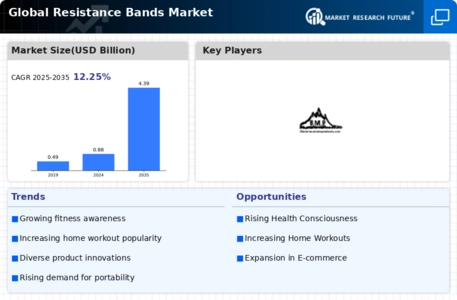Top Industry Leaders in the Resistance Bands Market

The resistance bands market, a prominent segment within the fitness and exercise equipment industry, has experienced significant growth as individuals increasingly incorporate versatile and convenient workout tools into their fitness routines. As of 2023, key players in this market have strategically positioned themselves to address the growing demand for resistance bands, offering a variety of products catering to different fitness levels and workout preferences.
Key Players:
- Performance Health Holding Inc. (US)
- Wacces, Inc. (US)
- Black Mountain Products, Inc. (US)
- ProsourceFit (US)
- Zaj Fit (US)
- Xtremebands (Canada)
- Bodylastics USA Inc. (US)
- Fitness Anywhere LLC (US)
- Decathlon S.A. (France)
- The Peach Builder Co. (New Zealand)
Strategies Adopted:
The resistance bands market deploy various strategies to maintain and enhance their market positions. Product diversification is a common approach, with brands offering resistance bands in different resistance levels, materials, and styles, providing options for users with varying fitness goals. Marketing strategies include online promotions, social media engagement, and collaborations with fitness influencers to create awareness and drive sales. Pricing strategies vary, with some brands positioning themselves as budget-friendly options targeting cost-conscious consumers, while others emphasize premium quality and additional features to attract fitness enthusiasts. Distribution strategies encompass both e-commerce platforms and traditional retail channels, ensuring broad accessibility to a diverse customer base. Additionally, brands focus on customer education, providing workout guides and instructional content to enhance the user experience and encourage consistent use of resistance bands.
Market Share Analysis:
The resistance bands industry involves evaluating several factors. Brand reputation and customer trust play a crucial role, with consumers often choosing well-known and reputable brands for their fitness equipment needs. The ability to offer a comprehensive range of resistance bands suitable for various exercises and fitness levels contributes to market share growth. Pricing competitiveness, promotional activities, and product availability across multiple sales channels impact market share dynamics. Quality of the bands, including durability, elasticity, and comfort, influences customer satisfaction and brand loyalty. Positive customer reviews and endorsements from fitness professionals also play a role in shaping brand perception and influencing market share within the highly competitive landscape.
News & Emerging Companies:
The resistance bands market has witnessed the emergence of new companies focusing on innovative band designs, eco-friendly materials, and technology integration. Emerging companies often leverage e-commerce platforms, influencer marketing, and partnerships with fitness apps to establish their presence in the competitive market. News in this industry typically revolves around product launches of specialized bands for specific workout styles, efforts to reduce environmental impact through sustainable materials, and collaborations with fitness influencers to enhance brand visibility.
Industry Trends:
The resistance bands market often highlights trends in technology integration, customization, and sustainability. Companies are increasingly investing in technology, exploring the integration of smart features into resistance bands, such as sensors or tracking capabilities, to enhance the user experience. Current investment trends reveal a focus on customization, with brands offering personalized resistance band sets or allowing users to choose specific resistance levels for their sets. Additionally, investments in research and development aim to create bands with innovative features, such as anti-snap technology or specialized grips, addressing evolving consumer preferences for safety and enhanced functionality.
Competitive Scenario:
The resistance bands market is characterized by a mix of established brands with a strong market presence and emerging players focusing on innovation and niche markets. Established brands leverage their experience, global marketing reach, and commitment to quality to provide consumers with a diverse selection of resistance bands. Emerging brands, on the other hand, focus on agility, unique designs, and eco-friendly practices to differentiate themselves in the competitive landscape.
The role of e-commerce has significantly impacted the competitive landscape, allowing both established and emerging brands to reach consumers directly, provide detailed product information, and offer subscription services for continuous fitness support. Brands that effectively utilize digital marketing, optimize the online shopping experience, and engage with consumers through educational content are better positioned to succeed in the evolving market.
Recent Development
The resistance bands market witnessed a notable development as TheraBand introduced a new line of resistance bands with an emphasis on sustainability. The innovation involved using eco-friendly materials in the manufacturing process, aligning with the growing consumer demand for environmentally conscious fitness products. TheraBand's investment in sustainable materials reflected a broader industry trend towards eco-friendly practices and showcased the company's commitment to addressing environmental concerns. The introduction of sustainable resistance bands demonstrated TheraBand's dedication to providing users with fitness equipment that aligns with their values and contributes to a more sustainable approach to wellness.











